Bond Characteristics of a Deformed Steel Bar Embedded in Donut-Type Voided Slab
Abstract
:1. Introduction
1.1. Research Scope and Objectives
1.2. Research Background
2. Bond Experiment
2.1. Experimental Variables
2.2. Material Experiment
2.3. Production of Specimens
2.4. Experimental Method
3. Experimental Results and Analysis
3.1. The Bond Stress–Slip Relationship of the Donut-Type Voided Slab
3.2. Crack Pattern of the Donut-Type Voided Slab
3.3. The Bond Stress Distribution of the Donut-Type Voided Slab
- : Elastic modulus of the deformed steel bar (MPa);
- : Diameter of the deformed steel bar (mm);
- : The deformed steel bar strength at the non-elastic region (kN);
- : The difference of the deformed steel bar strain between measurement points;
- : Distance between measurements points (mm).
4. Calculation of the Bond Strength of the Donut-Type Voided Slab
4.1. The Average Bond Strength of the Conventional Methods
- : The compressive strength of concrete (MPa);
- : Diameter of the deformed steel bar (mm);
- : The embedded length of a deformed steel bar (mm);
- : The minimum thicknesses of the cover surrounding the deformed steel bar [mm].
- : The compressive strength of concrete (MPa);
- : Diameter of the deformed steel bar (mm);
- : Cross sectional area of the deformed steel bar (mm2);
- : The embedded length of a deformed steel bar (mm);
- : The minimum thicknesses of the cover surrounding the deformed steel bar [mm];
- : The maximum thicknesses of the cover surrounding the deformed steel bar [mm].
- : The compressive strength of concrete (MPa);
- : The yield strength of the deformed steel bar (MPa);
- : The average bond stress of the deformed steel bar (MPa);
- : Diameter of the deformed steel bar (mm);
- : Cross sectional area of the deformed steel bar (mm2);
- : The embedded length of a deformed steel bar (mm);
- : Transverse reinforcement index;
- : The minimum thicknesses of the cover surrounding the deformed steel bar (mm);
- : The maximum thicknesses of the cover surrounding the deformed steel bar (mm).
4.2. The Method of Calculating the Bond Strength of the Donut-Type Voided Slab
- : Average bond stress of each region;
- : Embedded length of each region;
- : Total embedded length of re-bar.
- : the bond stress of each slip in the bond stress–slip curve;
- : the bond stress of each slip in the bond stress–slip curve.
5. Conclusions
- (1)
- The bond stress–slip relationship of the donut-type voided slab was affected by the bond region according to the void shapes and inner cover thickness. Particularly, when the minimum inner cover thickness of 2.5 was not satisfied, the difference of the maximum bond strength by bond region was large, and the failure behavior varied.
- (2)
- The bond stress distribution of the donut-type voided slab was also different from that of the general RC slab according to the inner cover thickness. When the inner cover thickness of 2.5 was not satisfied due to the void, the average bond stress was found to be 25~50% lower than that of the general RC slab in the region of the minimum inner cover, and the bond stress was generated mainly at transition region in which sufficient inner cover thickness was ensured.
- (3)
- In the conventional method, which calculates the bond strength using the minimum cover thickness only, bond characteristics of the donut-type voided slab in regions where bond conditions varied along the longitudinal direction of the rebar were not reflected. Thus, it was found that the conventional method underestimated the bond strength of the donut-type voided slab.
- (4)
- In this study, the method of calculating the bond strength considering the bond characteristics of each region was proposed. The analytic results indicated that the error range between the estimated value and the experimental value was within 5%, thus confirming that the estimated bond strength of the donut-type voided slab was highly accurate.
Author Contributions
Funding
Institutional Review Board Statement
Informed Consent Statement
Data Availability Statement
Conflicts of Interest
References
- ACI Committee 408-03. Bond and Development of Straight Reinforcing Bars in Tension (ACI 408R-03); American Concrete Institute: Farmington Hills, MI, USA, 2003. [Google Scholar]
- BubbleDeck Technology. BubbleDeck Voided Flat Slab Solutions—Technical Manual & Documents; BubbleDeck UK: Jersey, UK, 2008. [Google Scholar]
- Dwivedi, A.K.; Raj, R.; Mishra, P.P.; Kadhane, M.; Mohabey, B. Voided Slab Design: Review Paper. Int. J. Res. Sci. Innov. 2016, 4, 220–226. [Google Scholar]
- Valivonis, J.; Jonaitis, B.; Zavalis, R.; Skuturna, T.; Šneideris, A. Flexural capacity and stiffness of monolithic biaxial hollow slabs. J. Civ. Eng. Mag. 2014, 20, 693–701. [Google Scholar] [CrossRef] [Green Version]
- Sagadevan, R.; Rao, B.N. Experimental and analytical investigation of punching shear capacity of biaxial voided slabs. Structures 2019, 20, 340–352. [Google Scholar] [CrossRef]
- Lee, Y.E.; Ryu, J.H.; Ju, Y.K.; Kim, S.D.; Kim, J.K. Experimental evaluation on punching shear of two-way void slab-to-column connection with TVS lightweight ball. J. Archit. Inst. Korea 2011, 27, 3–10. [Google Scholar]
- Chung, J.H.; Choi, H.K.; Lee, S.C.; Choi, C.S. An Analytical Study on the Optimal Hollow Spheres in a Biaxial Hollow Slab. J. Archit. Inst. Korea 2011, 27, 3–10. [Google Scholar]
- Kim, B.H.; Chung, J.H.; Choi, H.K.; Lee, S.C.; Choi, C.S. Flexural Capacities of One-way hollow slab with Donut type Hollow Sphere. Key Eng. Mater. 2011, 452–453, 773–776. [Google Scholar] [CrossRef]
- Chung, J.H.; Choi, H.K.; Lee, S.C.; Choi, C.S. One-way Shear Strength of Circular Voided Reinforced Concrete Floor Slabs. Proc. Inst. Civ. Eng. Struct. Build. 2015, 168, 336–350. [Google Scholar] [CrossRef]
- Chung, J.H.; Bae, B.I.; Choi, C.S.; Jung, H.S.; Choi, C.S. Evaluation of punching shear strength of voided slabs considering the effect of the ratio b0/d. Eng. Struct. 2018, 164, 78–81. [Google Scholar] [CrossRef]
- Chung, J.H.; Bae, B.I.; Choi, C.S.; Jung, H.S.; Choi, C.S. Two-Way Flexural Behavior of Donut-Type Voided Slabs. Int. J. Concr. Struct. Mater. 2018, 12, 339–351. [Google Scholar] [CrossRef]
- Lee, S.B.; Kang, S.Y.; Kim, S.S.; Lee, J.S. Experimental Evaluation of Effective Flexural Ridigity in Reinforced Concrete Beams Considering Tension Stiffening Effect. J. Korea Concr. Inst. 2005, 17, 1033–1042. [Google Scholar] [CrossRef]
- Kim, W.; Lee, K.Y. Crack Spacing in RC Tension Members Considering Cover Thickness and Concrete Compressive Strength. J. Korea Soc. Civ. Eng. 2018, 38, 193–202. [Google Scholar] [CrossRef]
- Zuo, J.; Darwin, D. Bond Strength of High Relative Rib Area Reinforcing Bars; SM Report 46; University of Kansas Center for Research: Lawrence, KS, USA, 1998. [Google Scholar]
- Abrishami, H.H.; Mitchell, D. Influence of Splitting Cracks on Tension Stiffening. ACI Struct. J. 1996, 93, 703–710. [Google Scholar]
- Avak, R. Topic: BubbleDeck-A New Type of Hollow-Body Ceiling; Report No. 9919586; Institute of Concrete: Lyngby, Denmark, 2001; pp. 6–9. [Google Scholar]
- Kim, H.H.; Choi, C.S. Bond Stress-Strain Predict Model with Inner Cover Thickness of Steel Wire Used in Void Deck Plate. J. Archit. Inst. Korea 2018, 34, 41–51. [Google Scholar]
- KS F 2441; Standard Test Method for Comparing Concrete on the Basis of the Bond Developed with Reinforcing Steel. Korean Agency for Technology and Standards: Eumseong-gun, Korea, 2010; pp. 1–7.
- Azizinamini, A.; Stark, M.; Roller, J.J.; Ghosh, S.K. Bond Performance of Reinforcing Bars Embedded in High-Strength Concrete. ACI Struct. J. 1993, 90, 554–561. [Google Scholar]
- Zsutty, T. Empirical Study of Bar Development Behavior. J. Struct. Eng. 1985, 111, 205–219. [Google Scholar] [CrossRef]
- Zuo, J.; Darwin, D. Splice Strength of Conventional and High Relative Rib Area Bars in Normal and High-Strength Concrete. ACI Struct. J. 2000, 97, 630–641. [Google Scholar]
- CEB-FIP. CEB-FIP Model Code 2010 First complete draft, Volume 1; fib Bulletin No. 55; CEB-FIP: Lausanne, Switzerland, 2010; pp. 239–246. [Google Scholar]
- Rilem-Fip-Ceb. Bond test for reinforcing steel: 1-Beam test (7-II-28 D). 2-Pullout test (7-II-128): Tentative recommendations. Mater. Struct. 1973, 6, 96–105. [Google Scholar]

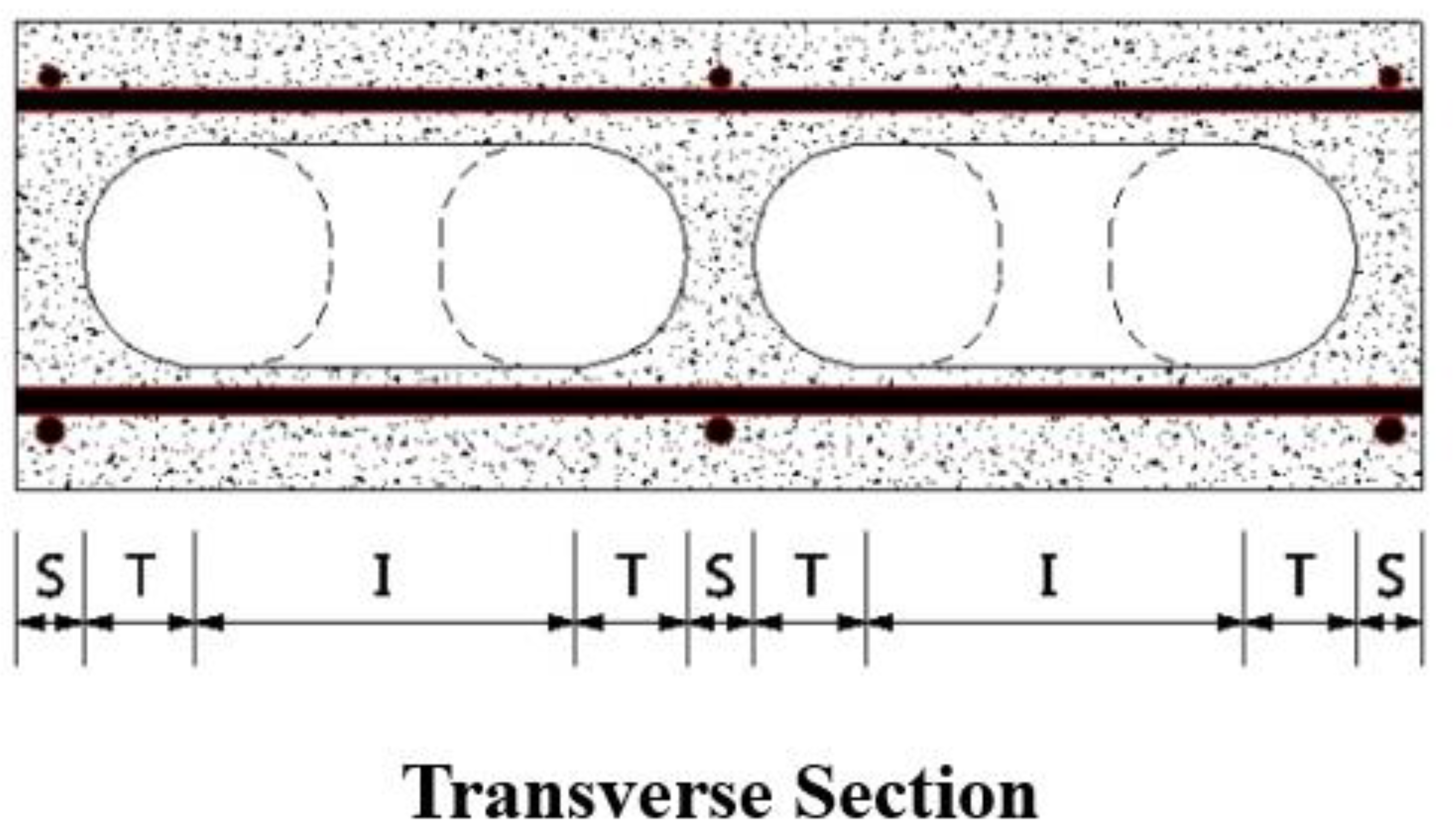
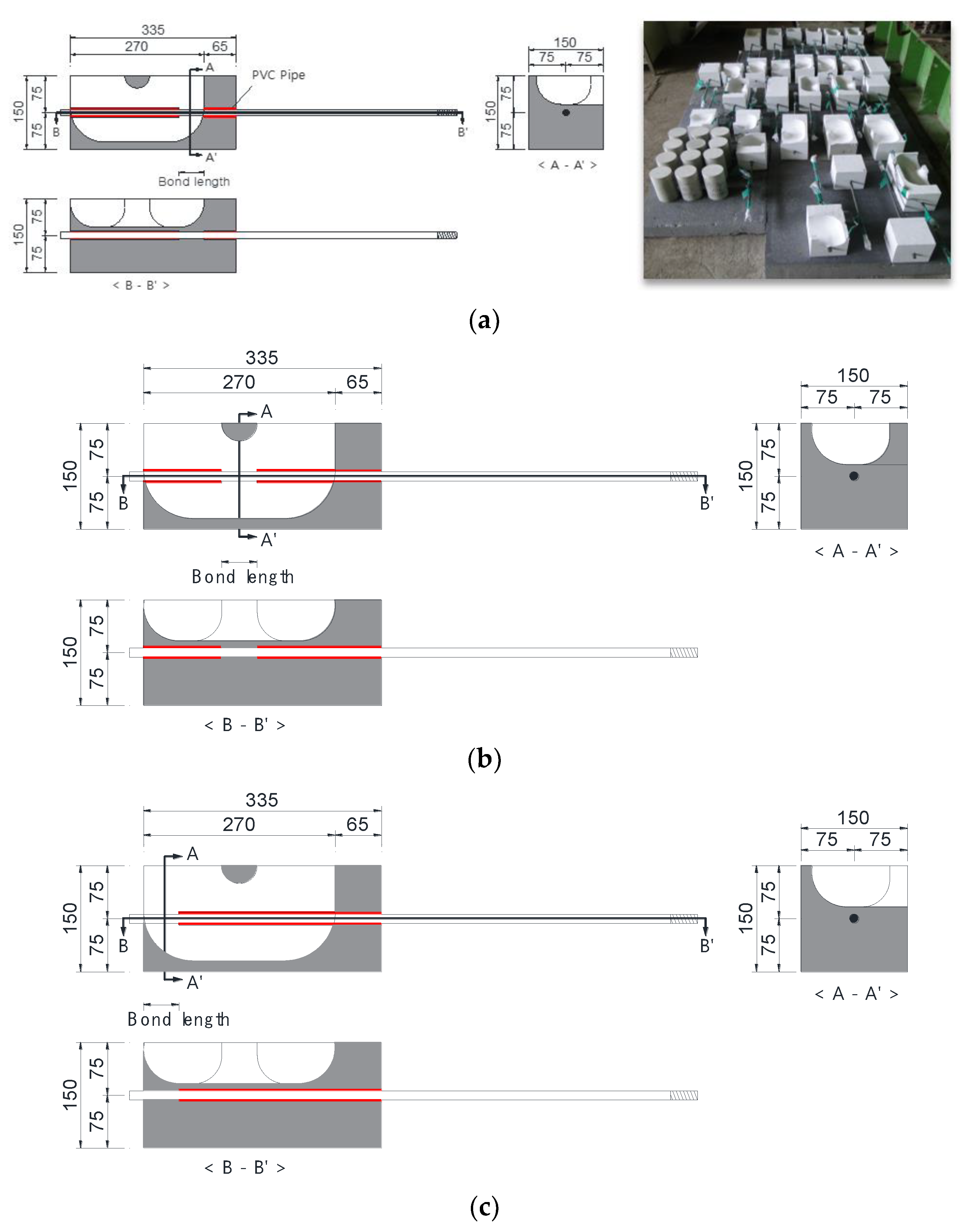
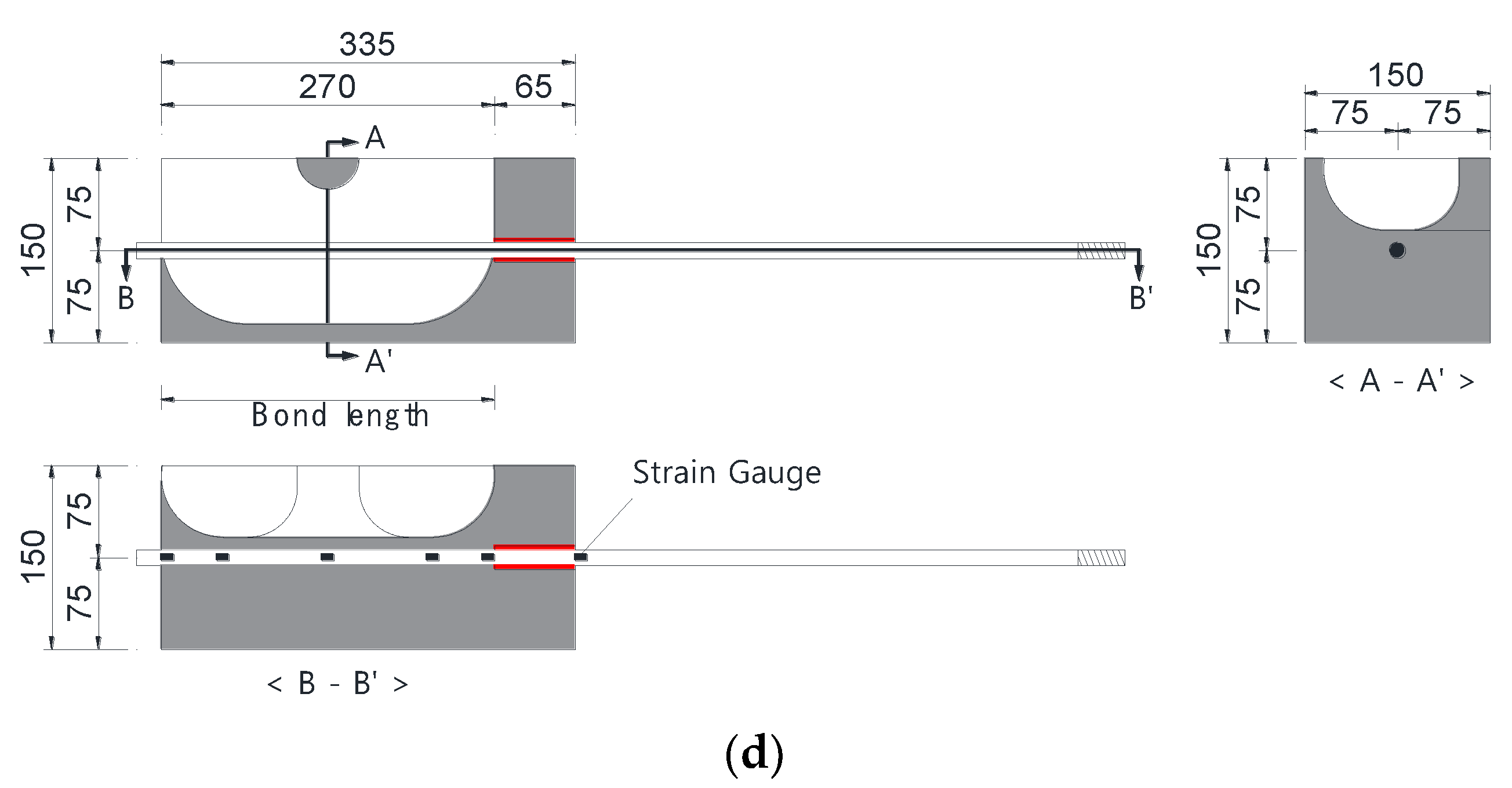

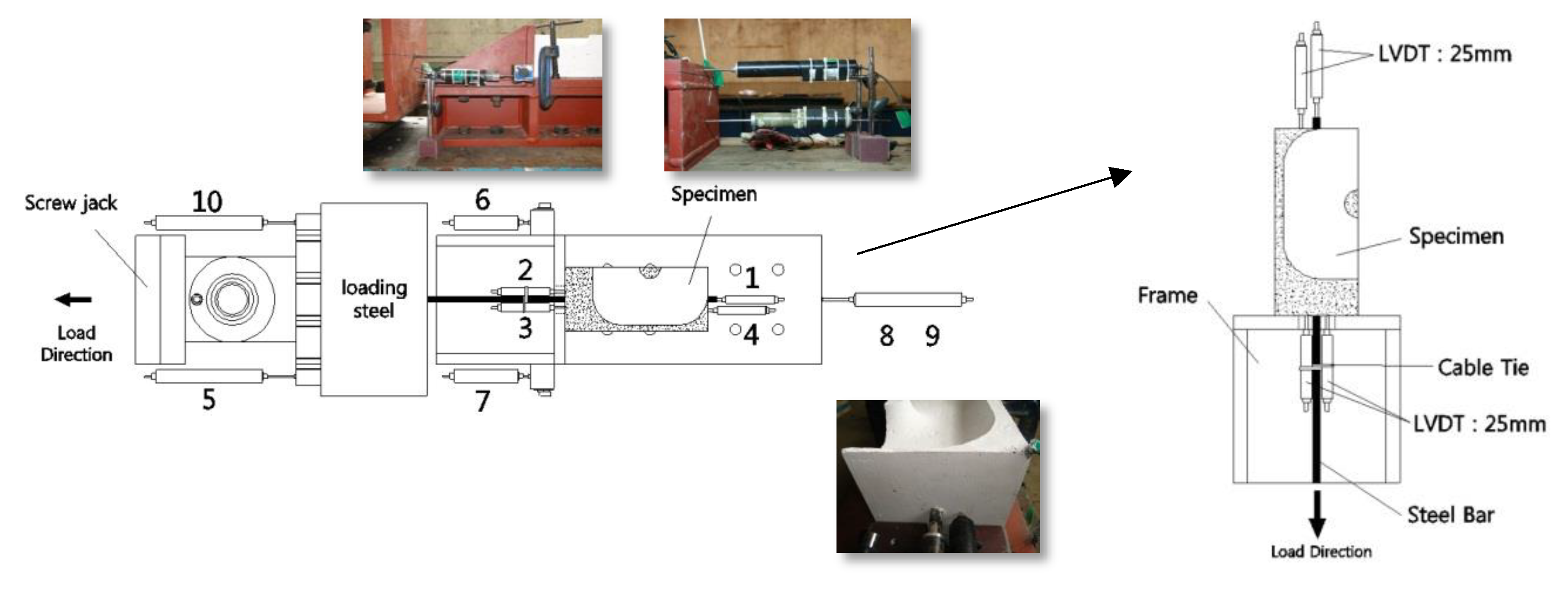
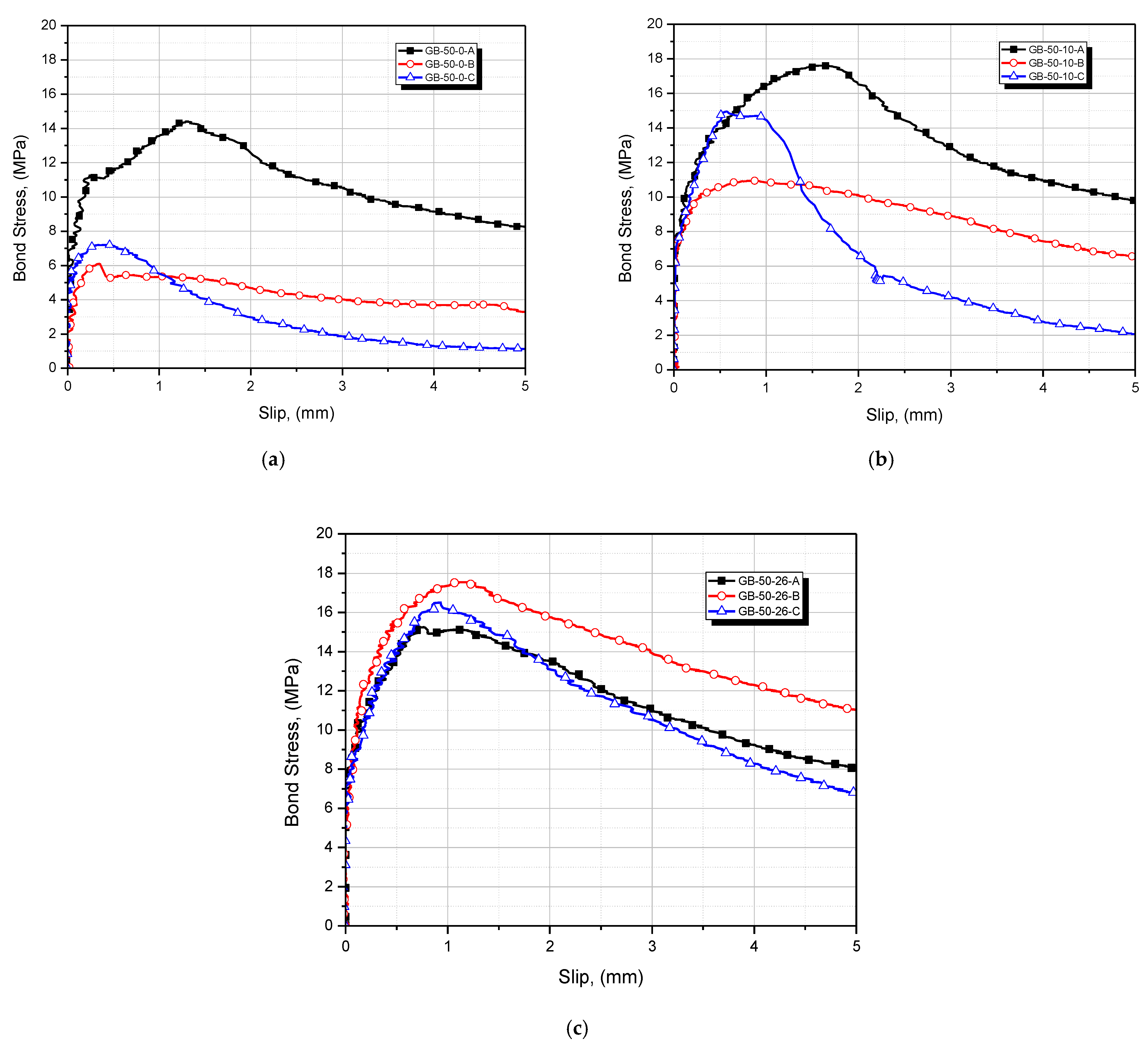
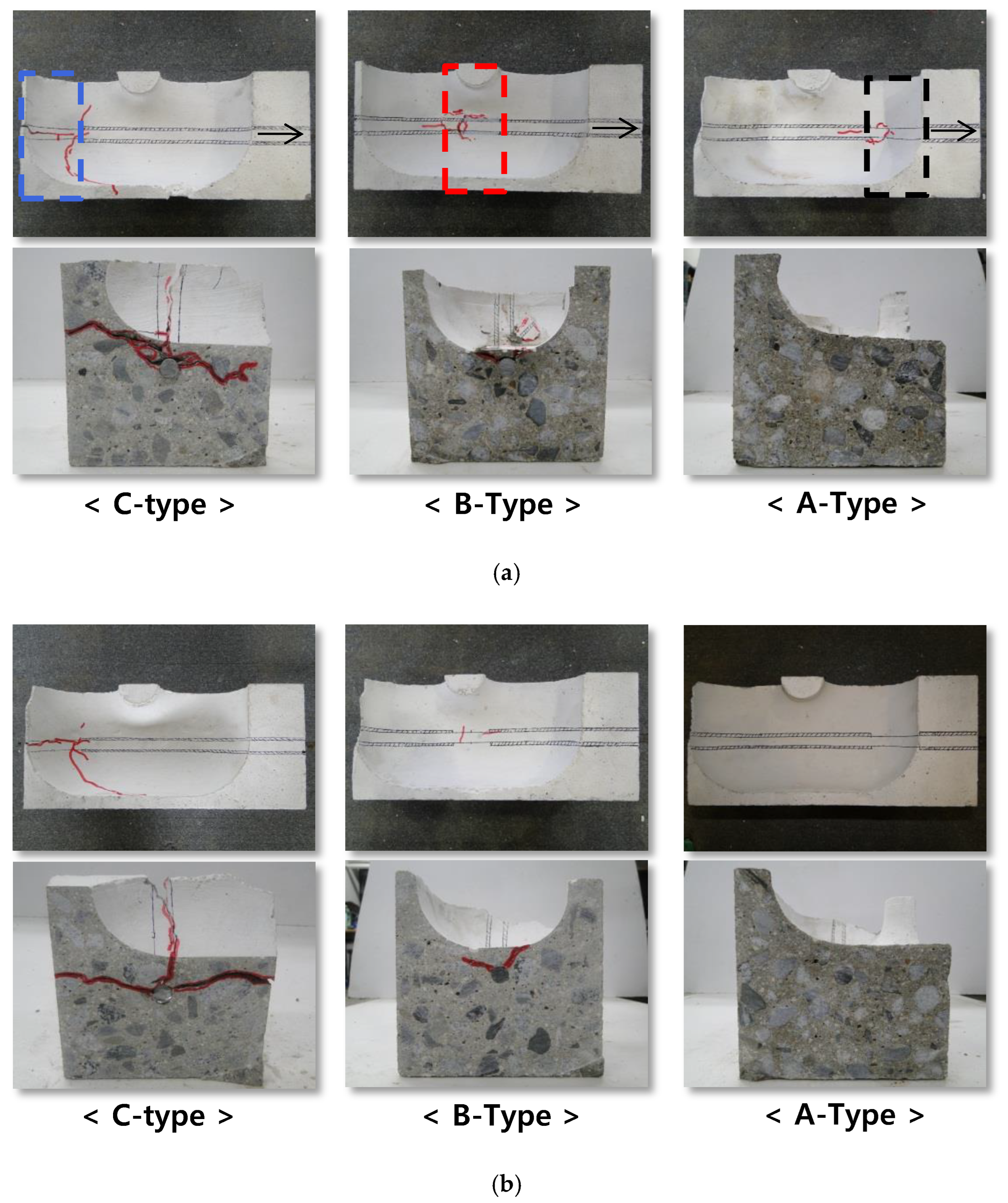
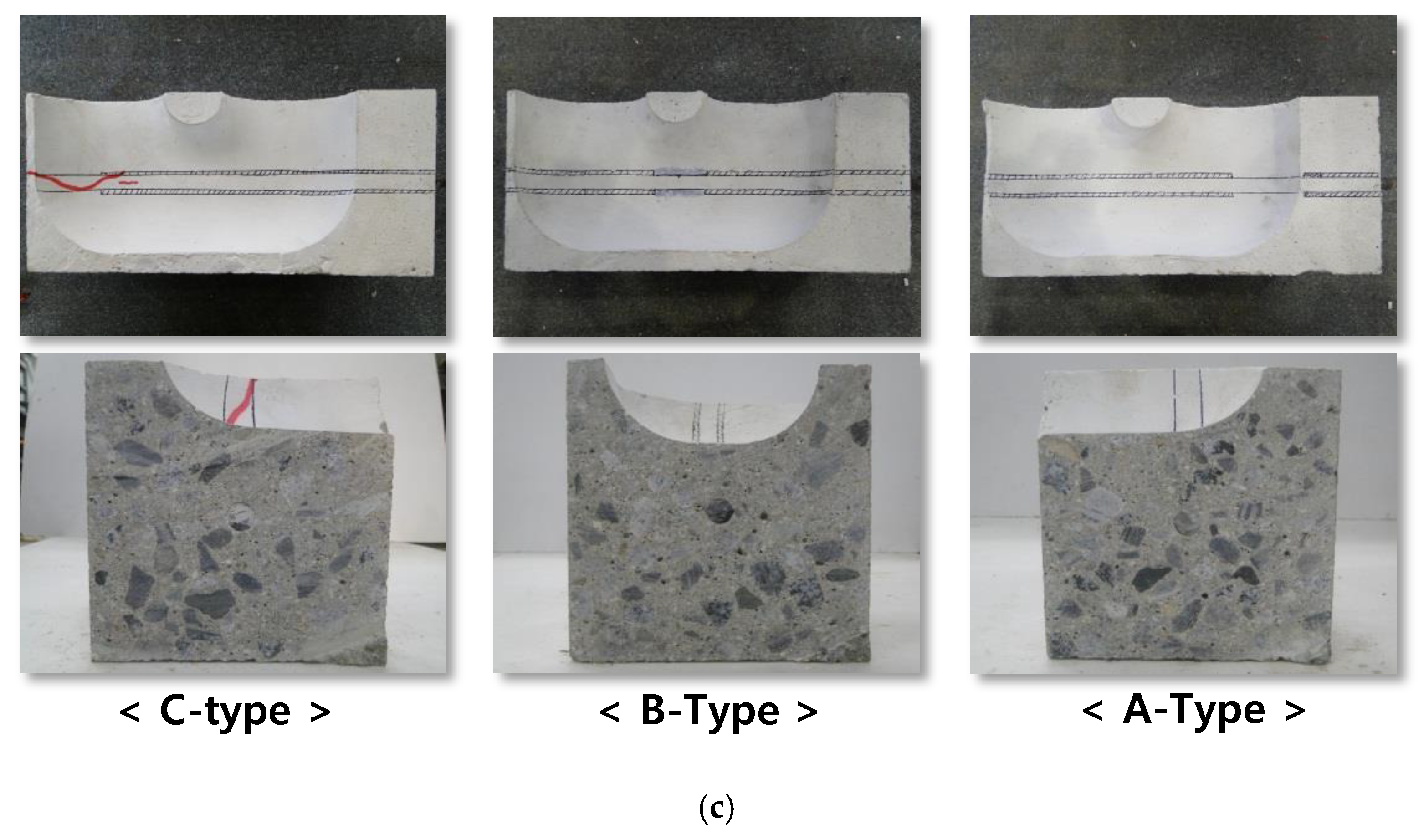
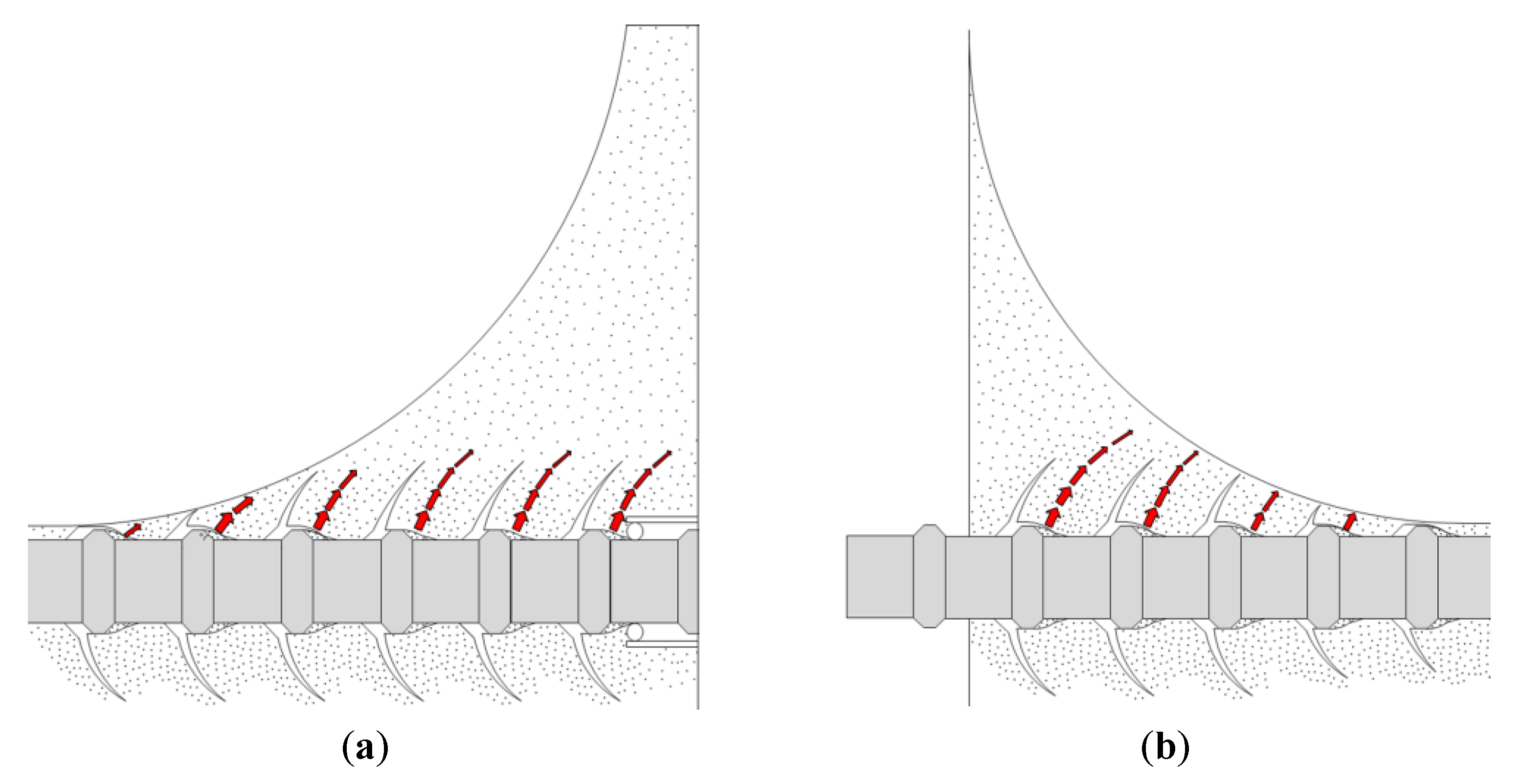

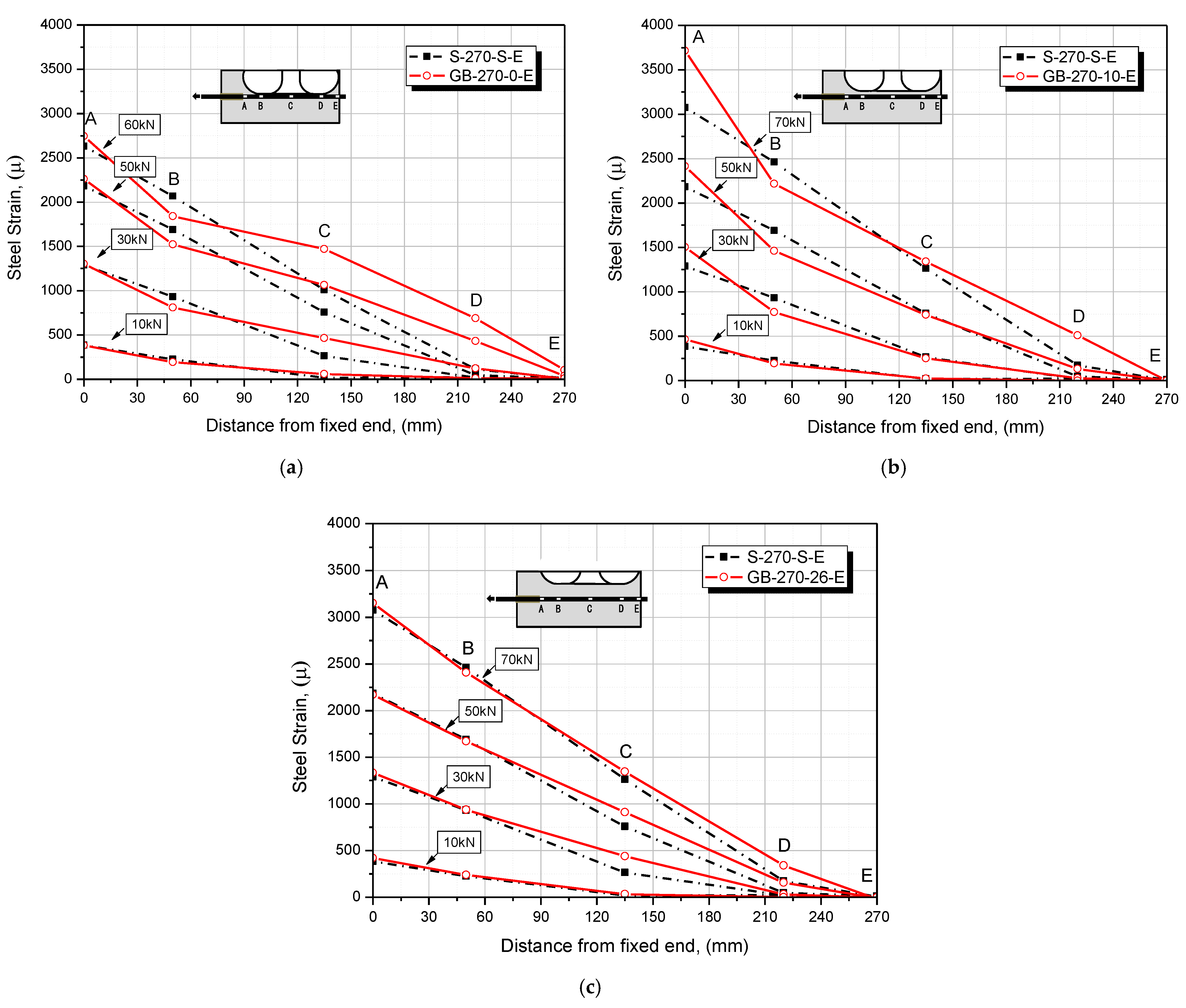
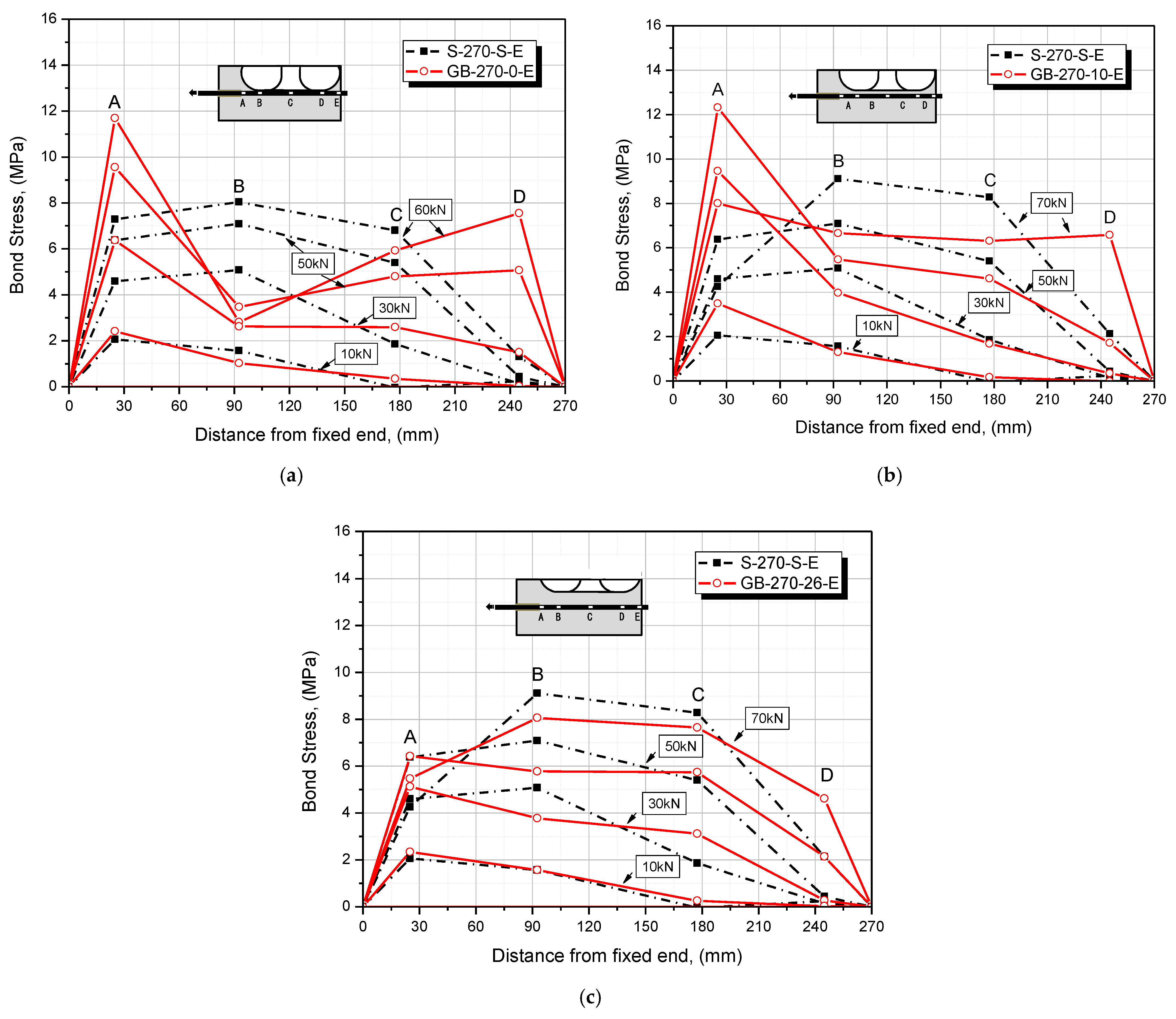

| Specimen | [MPa] | Rebar Diameter [mm] | Height [mm] | Width [mm] | Length [mm] | Parameters | ||
|---|---|---|---|---|---|---|---|---|
| Embedded Length [mm] | Inner-Cover Thickness [mm] | Bond Region | ||||||
| S-270-S-E | 30.4 | 12.7 (D13) | 150 | 150 | 335 | 270 | - | - |
| GB-270-0-E | 0 | Entire | ||||||
| GB-270-10-E | 10 | |||||||
| GB-270-26-E | 26 | |||||||
| GB-50-0-A | 50 | 0 | A-Type (Transition Region 1) | |||||
| GB-50-10-A | 10 | |||||||
| GB-50-26-A | 26 | |||||||
| GB-50-0-B | 0 | B-Type (Insufficient Region) | ||||||
| GB-50-10-B | 10 | |||||||
| GB-50-26-B | 26 | |||||||
| GB-50-0-C | 0 | C-Type (Transition Region 2) | ||||||
| GB-50-10-C | 10 | |||||||
| GB-50-26-C | 26 | |||||||
| Design Strength [MPa] | W/C [%] | S/a [%] | Unit Weight [kg/m3] | ||||
|---|---|---|---|---|---|---|---|
| W | C | S | G | Admixture | |||
| 30 | 44.2 | 46.9 | 165 | 373 | 837 | 966 | 1.87 |
| Rebar Type | Nominal Strength [MPa] | Yield Strength [MPa] | Ultimate Strength [MPa] | Elongation [%] | Elastic Modulus [GPa] |
|---|---|---|---|---|---|
| D13 | 500 | 576 | 751.57 | 12.21 | 203 |
| Specimen | Failure Mode | |||
|---|---|---|---|---|
| GB-50-0-A | 28.74 | 14.41 | 1.29 | Pullout |
| GB-50-10-A | 35.14 | 17.61 | 1.74 | Pullout |
| GB-50-26-A | 30.41 | 15.24 | 0.78 | Pullout |
| GB-50-0-B | 12.20 | 6.12 | 0.35 | Splitting |
| GB-50-10-B | 21.84 | 10.95 | 0.85 | Pullout |
| GB-50-26-B | 35.01 | 17.55 | 1.14 | Pullout |
| GB-50-0-C | 14.37 | 7.20 | 0.38 | Splitting |
| GB-50-10-C | 29.81 | 14.94 | 0.38 | Splitting |
| GB-50-26-C | 33.00 | 16.54 | 0.93 | Pullout |
| Specimen | Failure Mode | Location | |||
|---|---|---|---|---|---|
| S-270-S-E | 87.10 | 8.10 | 10.23 | Yielding | B |
| GB-270-0-E | 60.27 | 5.59 | 11.69 | Splitting | A |
| GB-270-10-E | 72.93 | 6.77 | 13.38 | Splitting | A |
| GB-270-26-E | 89.60 | 8.32 | 10.47 | Yielding | B |
| Specimen | Test Result | Conventional Method | Suggested Method | |||
|---|---|---|---|---|---|---|
[kN] | [kN] | [kN] | [kN] | [kN] | [kN] | |
| GB-270-0-E | 60.27 | 26.85 | 20.23 | 45.61 | 52.25 | 61.68 |
| GB-270-10-E | 72.93 | 42.78 | 28.88 | 56.50 | 76.61 | 77.30 |
| GB-270-26-E | 89.60 | 60.04 | 43.27 | 66.04 | 114.51 | 110.47 |
Publisher’s Note: MDPI stays neutral with regard to jurisdictional claims in published maps and institutional affiliations. |
© 2022 by the authors. Licensee MDPI, Basel, Switzerland. This article is an open access article distributed under the terms and conditions of the Creative Commons Attribution (CC BY) license (https://creativecommons.org/licenses/by/4.0/).
Share and Cite
Chung, J.-H.; Jung, H.-S.; Choi, H.-K. Bond Characteristics of a Deformed Steel Bar Embedded in Donut-Type Voided Slab. Appl. Sci. 2022, 12, 5666. https://doi.org/10.3390/app12115666
Chung J-H, Jung H-S, Choi H-K. Bond Characteristics of a Deformed Steel Bar Embedded in Donut-Type Voided Slab. Applied Sciences. 2022; 12(11):5666. https://doi.org/10.3390/app12115666
Chicago/Turabian StyleChung, Joo-Hong, Hyung-Suk Jung, and Hyun-Ki Choi. 2022. "Bond Characteristics of a Deformed Steel Bar Embedded in Donut-Type Voided Slab" Applied Sciences 12, no. 11: 5666. https://doi.org/10.3390/app12115666





